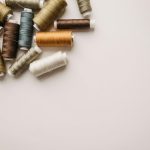You start by harvesting jute stalks when they mature in four to six months, then soak them in water for 10 to 20 days to loosen fibers through retting. Next, you strip and clean the softened fibers, removing dirt and pith, and dry them under controlled conditions. After sorting for quality, you spin the fibers into yarn, preparing them for weaving. Once you explore the weaving techniques, you’ll better understand how jute transforms into durable fabric.
Table of Contents
Key Takeaways
- Jute plants are harvested after 4-6 months when stalks mature but before flowering, ensuring strong fiber quality.
- Retting involves soaking stalks in water for 10-20 days to loosen fibers through natural microbial action.
- Fibers are stripped from stalks using wooden tools, then cleaned by rinsing and dry brushing to remove impurities.
- Drying is done at 30-40°C with 50-60% humidity for 24-48 hours, followed by sorting based on fiber quality.
- Spinning aligns and twists fibers into yarn, which is then woven using techniques like plain, twill, or jacquard.
Understanding the Growth and Harvesting of Jute Plants
Although jute plants thrive in warm, humid climates, you’ll find they need well-drained, fertile soil to grow best.
Jute plants flourish in warm, humid environments but require well-drained, fertile soil for optimal growth.
When you plant jute seeds, aim for a temperature between 24 and 37 degrees Celsius to promote rapid germination. You’ll want to water the crop regularly, but avoid waterlogging the roots.
Within four to six months, the stalks will reach maturity, standing tall and ready for harvest. When harvesting, you cut the stalks close to the ground, ideally before the plants flower to guarantee strong fibers.
Timing is key because if you wait too long, the fiber quality declines. After cutting, you bundle the stalks for transport. Handling the plants carefully during this stage helps preserve the fiber’s strength and texture, setting you up for a successful next step in jute processing.
The Retting Process: Extracting Fibres From the Stalks
Begin the retting process by soaking the harvested jute stalks in water to loosen the fibers from the woody core.
You’ll submerge the stalks in slow-moving water, such as ponds, streams, or tanks, allowing natural microbial activity to break down the pectin binding the fibers. This typically takes 10 to 20 days, depending on temperature and water quality.
You need to monitor the stalks regularly, turning them occasionally to guarantee even retting and prevent rotting. When the fibers start separating easily from the stalks, the retting is complete.
At this stage, you can remove the stalks from the water, ready to move on to extracting and processing the fibers further. Proper retting is essential—it affects fiber quality, strength, and color, so don’t rush this step.
Stripping and Cleaning: Preparing the Fibres for Use
Once the retting process is complete, you can strip the softened fibers from the stalks by hand or with simple tools. This stripping removes the outer layer and separates the long fibers. Next, you’ll clean the fibers by washing them in water to remove dirt, gum, and remaining pith. Proper cleaning guarantees the fibers are soft and ready for spinning.
Here’s a quick overview of stripping and cleaning steps:
| Step | Action | Purpose |
|---|---|---|
| Stripping | Remove fibers by hand | Separate fibers from stalks |
| Scraping | Use a wooden knife | Detach outer layers |
| Washing | Rinse with water | Remove impurities |
| Dry brushing | Brush fibers gently | Loosen fibers for further use |
Drying and Sorting: Ensuring Quality and Consistency
You’ll want to dry the jute fibers under ideal conditions to preserve their strength and texture.
Next, assess each batch carefully to guarantee consistent quality before sorting.
Using the right techniques and tools will help you organize fibers efficiently for the best fabric results.
Optimal Drying Conditions
Achieving ideal drying conditions is essential for preserving the strength and texture of jute fibers. You want to dry the fibers evenly under controlled temperature and humidity to prevent brittleness or mold growth. Typically, drying jute in open, shaded areas with good airflow helps maintain its natural luster without over-drying.
Here’s a quick overview of suitable drying conditions:
| Condition | Recommended Range |
|---|---|
| Temperature | 30°C to 40°C (86°F-104°F) |
| Humidity | 50% to 60% |
| Drying Duration | 24 to 48 hours |
Fiber Quality Assessment
Proper drying sets the stage for accurately evaluating fiber quality. Once the jute fibers are thoroughly dried, you can assess their moisture content, strength, and color without interference from dampness.
Dry fibers reveal their true texture and flexibility, which are essential for determining usability. You’ll want to examine the fibers for uniformity—looking for consistent thickness and length—since inconsistencies can affect the final fabric’s strength and appearance.
Checking for impurities like dust or residual plant matter is also key, as these impact dyeing and weaving processes. By carefully inspecting the dried fibers for these qualities, you guarantee only the best are selected for further processing.
This step lays the foundation for producing high-quality jute fabric with durability and visual appeal.
Sorting Techniques and Tools
Sorting plays an essential role in maintaining the quality and consistency of jute fibers before they move on to weaving.
You’ll begin by drying the fibers thoroughly to reduce moisture content, which prevents mold and guarantees durability.
Once dry, you’ll sort the fibers based on length, color, and strength using simple tools like hand-held combs and sieves. These tools help remove impurities and separate fine fibers from coarser ones.
You can also use mechanical sorters for larger batches to speed up the process. By carefully selecting only the best-quality fibers, you guarantee the final fabric is strong and uniform.
Spinning Jute Fibres Into Yarn
Before you can weave jute fibers into fabric, you need to spin them into yarn. Spinning aligns the fibers, twists them together, and forms a continuous thread strong enough for weaving. You can use traditional hand spinning or modern machines, depending on your scale.
Here’s a quick look at the spinning process steps:
| Step | Description | Outcome |
|---|---|---|
| Preparation | Carding fibers to align them | Smooth fiber mass |
| Drafting | Pulling fibers to thin sliver | Uniform thin strand |
| Twisting | Adding twist for strength | Strong, continuous yarn |
| Winding | Rolling yarn onto spools | Ready-to-use yarn |
Master these steps, and you’ll create quality jute yarn perfect for weaving.
Weaving Techniques Used in Jute Fabric Production
Once you’ve spun the jute yarn, you can start weaving it into fabric using various techniques that determine the texture and strength of the final product.
The most common method is plain weaving, where you interlace the yarns in a simple over-under pattern. This creates a strong, durable fabric ideal for sacks and bags.
You might also try twill weaving, which produces a diagonal rib pattern, adding flexibility and a smoother texture.
For decorative or finer items, you can use jacquard weaving to create intricate patterns by controlling each warp thread individually.
Whichever technique you choose, controlling tension and yarn density is vital to guarantee uniformity and durability.
The Role of Jute Fabric in Sustainable Textile Industry
Sustainability drives the growing demand for eco-friendly materials, and jute fabric plays an essential role in this shift. When you choose jute, you support a textile that’s biodegradable, renewable, and requires minimal chemical processing. This makes it a smart choice for reducing your environmental impact.
Here’s why jute fabric matters in sustainable textiles:
- Eco-Friendly Growth: Jute plants absorb large amounts of CO2 and improve soil health without heavy pesticides.
- Biodegradable Material: Unlike synthetic fabrics, jute decomposes naturally, cutting down landfill waste.
- Energy-Efficient Production: Jute processing consumes less energy, lowering your carbon footprint.
Frequently Asked Questions
What Are the Main Countries That Produce Jute Globally?
You’ll find that Bangladesh and India lead the world in jute production, supplying most of the global demand. Smaller contributions come from China, Thailand, and Nepal, but these two dominate the industry by far.
How Does Jute Fabric Compare to Cotton in Durability?
You’ll find jute fabric less durable than cotton since it’s coarser and weaker. However, jute is more eco-friendly and breathable, making it great for bags and rugs, while cotton suits soft, everyday clothing better.
Can Jute Fibers Be Dyed in Various Colors?
Yes, you can dye jute fibers in various colors, but they absorb dyes differently than cotton. You’ll need specific dye types and techniques to guarantee vibrant, long-lasting colors without compromising jute’s natural texture and strength.
What Are Common Products Made From Jute Fabric?
You’ll find jute fabric in bags, rugs, curtains, and upholstery. You’ll see it in sacks, mats, and wall hangings. It’s versatile, eco-friendly, and durable, making it perfect for everyday practical and decorative products you use.
How Is Jute Fabric Maintained and Cleaned Properly?
You should vacuum jute fabric regularly and spot clean stains immediately with mild soap and water. Avoid soaking it, and keep it away from direct sunlight to prevent fading and maintain its natural texture.
- Does Chiffon Fabric Stink - July 15, 2025
- Does Chiffon Fabric Affect the Economy - July 15, 2025
- Does Cotton Fabric Have a Nap - July 15, 2025







